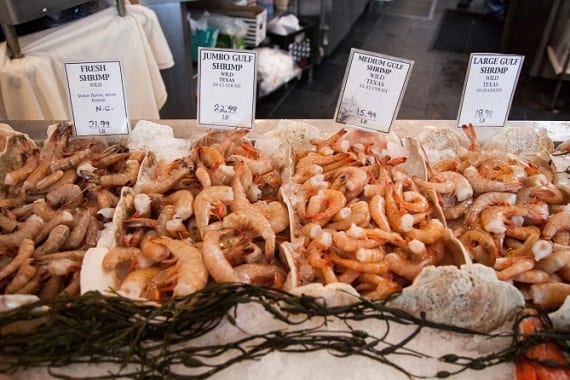November 5, 2014
Five Must-Know Facts about The Shrimp You Eat from Oceana’s Recent Report
As America’s favorite seafood, there’s a good chance you’ve consumed shrimp before, whether that be as shrimp salad, shrimp scampi, or battered coconut shrimp. And while all of those dishes are absolutely delicious, consumers don’t often realize what they’re getting when they order “shrimp.”
Similar to other seafood selections—say sockeye salmon and coho salmon, or littleneck and longneck clams—many different species lie behind the general “shrimp” term. From the pink, brown, and white shrimp species of the Gulf of Mexico, to the farmed and often imported whiteleg shrimp, the shrimp on your dinner plate is not always what you assume. This carries health and economic risks for consumers, whose wallets may be deceived by the shrimp they’re actually receiving, especially if it comes from a farmed or an illegal and unregulated source.
Last week, Oceana released a new report uncovering widespread misrepresentation associated with shrimp. Shrimp misrepresentation was found in 30 percent of 143 samples, and was found in all four areas of the U.S. that Oceana tested.

(Photo: Oceana)
In case you missed Oceana’s blog coverage last week, we’re outlining five of the most important facts from the report. Take a look below to learn more.
- The most commonly substituted shrimp species was farmed whiteleg shrimp. We found this shrimp disguised as “wild” shrimp and “Gulf” shrimp, among others. Oceana uncovered dishes like Gulf shrimp cocktail, Bronzed Carolina shrimp, and popcorn shrimp to actually be whiteleg shrimp.
- Forty percent of the 20 shrimp species or categories collected and identified in Oceana’s study were not known to be sold in the U.S. One shocking discovery was uncovering a banded coral shrimp, an aquarium pet, in a bag of frozen Vietnamese wild salad-sized shrimp.
- New York City had the highest amount of shrimp misrepresentation at 43 percent, followed by Washington, D.C., the Gulf of Mexico region, and Portland, Oregon.
- All shrimp labeled as being “farmed” were accurately labeled; alternately, over half of the samples labeled as just “shrimp” were wild caught—representing a missed marketing opportunity for vendors.
- Out of the 600 restaurant menus surveyed, most did not provide diners with any information about the shrimp they served, including what type of shrimp it was, where it was from, and whether it was farmed or wild-caught.
President Obama’s recently designated Task Force on Combatting Illegal, Unreported, and Unregulated (IUU) Fishing and Seafood Fraud is developing solutions to tackle these problems now. Please join us in calling for seafood traceability to track shrimp from boat or farm to plate, allowing consumers to have more information about their shrimp. Click here to sign Oceana’s petition to call on President Obama’s IUU and seafood fraud task force to recommend traceability for all seafood sold in the U.S.
MOST RECENT
September 3, 2025
Air Raid Panic to Informed Skies and Seas: The National Weather Service in a Nutshell
August 29, 2025
August 22, 2025
Corals, Community, and Celebration: Oceana Goes to Salmonfest!



